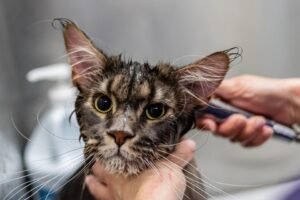
Caring for a cat’s skin and fur is crucial to their overall health and happiness. Cats are known for their meticulous self-grooming habits, but they still need assistance from their human companions to maintain optimal skin health and a shiny, healthy coat. This article will explore essential cat skin care tips and practices to ensure your feline friend enjoys a luxurious coat and vibrant skin.
Understanding Your Cat’s Skin and Fur
Before diving into the skin care tips, it’s important to understand the basic structure and function of a cat’s skin and fur. A cat’s skin is its largest organ, serving as a protective barrier against environmental hazards and helping to regulate body temperature. The fur, which comes in various lengths, textures, and colors, serves as insulation and plays a role in communication and sensory perception.
Common Skin and Fur Issues in Cats
Cats can experience several skin and fur problems, ranging from mild to severe. Common issues include:
- Fleas and ticks
- Allergic reactions
- Fungal infections like ringworm
- Dry skin or dandruff
- Matted fur
- Excessive shedding
Recognizing and addressing these issues promptly is essential for maintaining your cat’s skin and fur health.
Regular Grooming Practices
Regular grooming is the cornerstone of cat skin care. It helps remove loose fur, dirt, and debris, while also distributing natural oils that keep the skin moisturized and the fur shiny.
Brushing
Brushing your cat regularly is one of the most effective ways to maintain a healthy coat. The frequency of brushing depends on the type of fur your cat has:
- Short-haired cats: Once a week is usually sufficient.
- Medium to long-haired cats: Daily brushing is recommended to prevent mats and tangles.
Use a brush or comb appropriate for your cat’s fur type to ensure comfort and effectiveness.
Bathing
Cats are generally self-sufficient when it comes to cleaning themselves, but occasional baths can be beneficial, particularly for cats with skin conditions or those that get into messes. Use a mild cat-specific shampoo and ensure thorough rinsing to avoid irritation.
Nutrition for Healthy Skin and Fur
Proper nutrition is fundamental to your cat’s skin and fur health. A balanced diet provides the necessary nutrients to support skin integrity and fur quality.
Essential Nutrients
Ensure your cat’s diet includes:
- Omega-3 and Omega-6 fatty acids: These essential fatty acids help maintain skin moisture and reduce inflammation.
- High-quality proteins: Proteins are the building blocks of skin and fur, so ensure your cat’s diet includes sufficient amounts.
- Vitamins and minerals: Vitamins A, E, and B-complex, along with zinc and copper, are crucial for healthy skin and fur.
Consider discussing your cat’s dietary needs with a veterinarian, who may recommend supplements if necessary.
Hydration and Its Importance
Hydration plays a vital role in maintaining healthy skin and fur. Ensure your cat has access to fresh, clean water at all times. Cats often prefer running water, so consider investing in a cat water fountain to encourage them to drink more.
Environmental Factors
The environment your cat lives in can significantly impact its skin and fur health. Consider the following factors:
Humidity
Low humidity can lead to dry skin and increased shedding. Using a humidifier during dry seasons can help maintain optimal skin moisture.
Allergens
Common household allergens, such as dust mites, pollen, and mold, can trigger skin reactions in cats. Regular cleaning and air filtration can help minimize these allergens.
Monitoring for Skin Issues
Regularly inspect your cat’s skin and fur for any signs of trouble. Early detection and intervention can prevent minor issues from becoming severe problems.
Signs to Watch For
Be on the lookout for the following signs of skin issues:
- Excessive scratching or licking
- Red, inflamed skin
- Scabs or sores
- Unusual odors
- Bald patches or thinning fur
If you notice any of these signs, consult your veterinarian for a proper diagnosis and treatment plan.
Flea and Tick Prevention
Fleas and ticks are common pests that can cause significant discomfort and lead to skin issues in cats. Implement effective flea and tick prevention measures to protect your cat.
Consult your veterinarian for the best prevention options, which may include topical treatments, oral medications, or collars. Regularly check your cat for signs of fleas or ticks, especially if they spend time outdoors.
Conclusion
Maintaining your cat’s skin and fur health is a multifaceted process that involves regular grooming, proper nutrition, adequate hydration, and environmental management. By following these essential cat skin care tips, you can ensure your feline companion enjoys a healthy, shiny coat and vibrant skin. Remember, regular veterinary check-ups are crucial for monitoring your cat’s overall health and addressing any skin or fur concerns promptly.
By being proactive and attentive to your cat’s needs, you can contribute significantly to their comfort and well-being, resulting in a happy, healthy, and beautiful feline friend.






